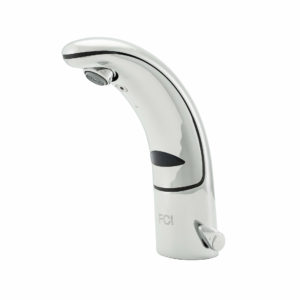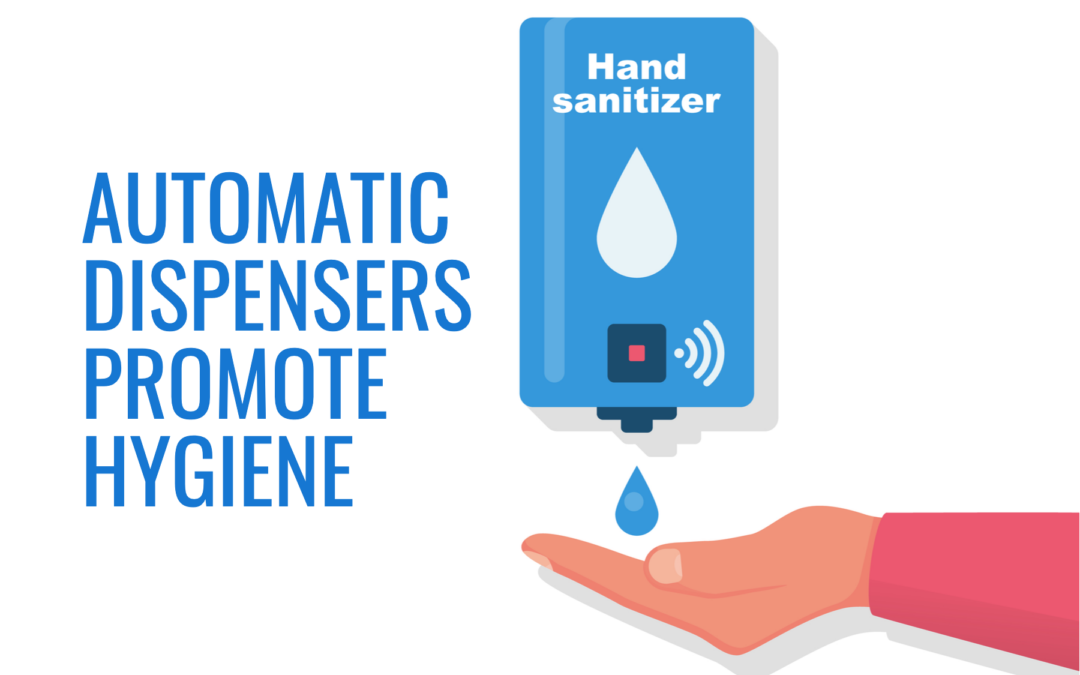People are keenly aware of germs in public washrooms, which is why automatic dispensers are now commonplace. To avoid touching surfaces, 66% of all public bathroom users enact a hygienic version of charades between entry and exit: Feet flush toilets, elbows swing open stall doors and push soap dispenser buttons, and paper towel-protected hands turn on and off taps. That same paper towel buffer is used to open the bathroom door, turning the last germ-avoidance manoeuvre into an NBA-style dirty paper towel shot into a nearby garbage can.
The dance is warranted; surfaces in public facilities are breeding grounds for viruses and bacteria. Toilets, sinks, faucets, flush handles, door handles, and paper towel dispensers all pick up germs from unwashed hands and pass them on to the next user—the fewer surfaces you touch, the better.
Charles Gerba, Ph.D., a microbiologist at the University of Arizona, Tucson, observes: “Touchless technology is a good idea because hard surfaces are significant transfer points for bacteria and viruses.” He says: “Much of what people put down on a surface can be picked up by the next person who comes along, and in an age where people share more spaces and surfaces than ever before, touchless technology can help prevent cross-contamination.”
That’s why, in the last few years, public restrooms have converted into touchless environments. With self-flushing toilets, touchless faucets, touch-free soap dispensers, automated paper towel dispensers, and sensor hand dryers, visiting a public washroom is now a surfaceless experience—that’s the expectation.
Touchless technology for residential bathrooms
Automatic dispensers have grown to be commonplace in commercial applications and public facilities. But, since the pandemic, contactless fixtures are making their way into residential kitchens and bathrooms as well. Preventing the spread of germs is equally important at home as it is in the workplace and public areas. As an added bonus, cleaning touch-free faucets and automatic soap dispensers is easier.
Washing hands frequently with soap is recommended as the most basic precaution for everyone to prevent the spread of the COVID-19 virus.
Family members have gotten used to washing their hands as soon as they get home. The home bathroom and kitchen sink has suddenly become more of a focal point because families want to stop bacteria and viruses from entering their house. Hand washing takes care of the germs on your hands but, if you have touch faucets and soap or sanitizer dispensers, that can be at the unintentional expense of the next family member who touches that contaminated surface. That’s why contactless, sensor-based fixtures are growing in popularity—rapidly.
The need for strategically placed hand sanitizer automatic dispensers
Shared facilities like washrooms, toilets, and even eating places in offices, schools, and other institutions pose the greatest threat of disease transmission. Hard surfaces such as stainless steel are significant transfer points for pathogens. Elevators, escalators, and stair handrails are laden with bacteria and viruses.
In these environments, one way to curb the spread of disease is to strategically place automatic soap or sanitizer dispensers. The idea is to keep germs off the skin at the most frequent place of contact. Traditional dish soap or manual dispensers suffer contamination on touch. Using touchless automatic dispensers is the answer.
Automatic dispensers are already the gold standard for dispensing foaming soap and hand sanitizer in institutional settings and public facilities. They are used extensively in schools, healthcare facilities, government agencies, cinemas, malls, and corporate offices.
In residences, touchless hand sanitizer dispensers are ideal at the front door, and automatic soap dispensers are finding their way to the home kitchen sink and in bathrooms to maintain good hand hygiene.
What makes for an excellent automatic dispenser?
A touchless dispenser has intelligent components that detect the presence of an object and automatically dispense liquid soap or sanitizer. Powered by a long-life battery, the sensor triggers the dispensing mechanism. When the sensor no longer detects the presence of the object, the valve shuts off the flow. Some things to look for
- Select a robust, durable design if you want to get the full benefits of an automatic dispenser for soap or an alcohol-based sanitizer.
- For a product with high-frequency usage, you want long periods of trouble-free operation. Batteries must be long-lasting, spare batteries must be easy to procure and replace.
- Your hand must fit easily under the sensor and the spout without touching any surface.
- It is also important that the dispenser releases the correct quantity of soap or sanitizer for effective cleaning.
Benefits of installing automatic dispensers for soap and sanitizer
There are several benefits of installing a device that automatically dispenses soap or hand sanitizer:
- Reduce the risk of cross-infection: Since there is no contact with any surface before or after washing, the chance of passing on any infection is minimal.
- Encourage usability: Touchless ease-of-use influences hygiene behaviour—people tend to use an automated dispenser more frequently than if they had to operate a manual dispenser. Touchless is also easier for young children and seniors who struggle to reach across countertops to access a manual dispenser.
- Decrease employee sickness or absence in workplaces: This is the direct result of improved hygiene behaviour.
- Ideal for high volume traffic: An automatic dispenser’s quick response makes it ideal for use where the number of users or frequency of use is high.
- Economical & eco-friendly: Automated dispensers reduce wastage. A standard amount of soap or sanitizer dispenses every time – the right amount for proper hygiene and nothing more! Since they are refillable, they reduce the usage of disposable plastic dispensers.
- Particularly useful in kitchens: Kitchen surfaces are a breeding ground for bacteria and viruses in the home. Going touchless is a great way to prevent infection from spreading at home.
- Looks good, too: An automatic dispenser is an impressive upgrade to your kitchen or bathroom sink. Available in sleek designs and attractive finishes, touch-free dispensers add a touch of class to your home.
At Faucets Canada, we craft the most innovative, technologically-advanced hands-free sanitary fixtures in the Canadian market. Our soap and sanitizer dispensers offer you all the benefits of hygiene, comfort, and economy. Superb design, sleek-looking exterior, and a durable exoskeleton make our automatic dispensers the ideal upgrade to touchless technology. For home or commercial applications, visit our online store.







